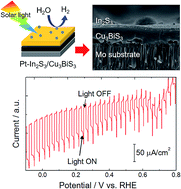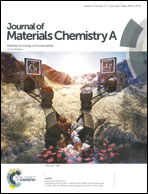Platinum and indium sulfide-modified Cu3BiS3 photocathode for photoelectrochemical hydrogen evolution†
Abstract
A polycrystalline Cu3BiS3 film as a photoelectrode was fabricated by an electrodeposition method on a molybdenum-coated glass substrate for photoelectrochemical hydrogen evolution. The Cu3BiS3 film was composed of dense crystallites with thicknesses of ca. 0.65 μm, and the optical bandgap was estimated to be ca. 1.6 eV. Photoelectrochemical characterization revealed that the Cu3BiS3 film was a p-type semiconductor with a flat band potential of ca. +0.1 V (vs. Ag/AgCl at pH 6), which is suitable for water reduction but cannot be used for water oxidation. Deposition of an In2S3 buffer layer, by which effective contact between p-type Cu3BiS3 and n-type In2S3 was formed, resulted in a significant increase in the photocurrent and a large shift of the photocurrent onset to the positive region. H2 evolution under AM 1.5G simulated solar light was demonstrated using the Pt–In2S3/Cu3BiS3 electrode combined with a Pt electrode under an applied bias (0 V vs. RHE).



 Please wait while we load your content...
Please wait while we load your content...